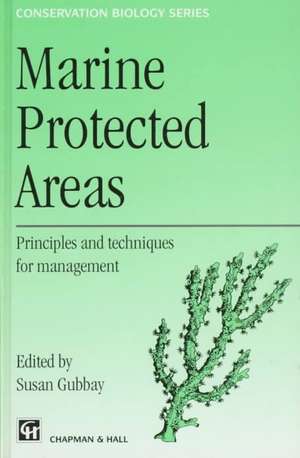Marine Protected Areas: Principles and techniques for management: Conservation Biology, cartea 5
Editat de S. Gubbayen Limba Engleză Hardback – 31 iul 1995
| Toate formatele și edițiile | Preț | Express |
|---|---|---|
| Paperback (1) | 1222.62 lei 6-8 săpt. | |
| SPRINGER NETHERLANDS – 4 oct 2012 | 1222.62 lei 6-8 săpt. | |
| Hardback (1) | 1058.94 lei 38-44 zile | |
| SPRINGER NETHERLANDS – 31 iul 1995 | 1058.94 lei 38-44 zile |
Din seria Conservation Biology
- 11%
 Preț: 510.79 lei
Preț: 510.79 lei -
 Preț: 396.12 lei
Preț: 396.12 lei - 11%
 Preț: 474.83 lei
Preț: 474.83 lei - 18%
 Preț: 997.88 lei
Preț: 997.88 lei -
 Preț: 428.90 lei
Preț: 428.90 lei - 18%
 Preț: 957.44 lei
Preț: 957.44 lei - 11%
 Preț: 511.40 lei
Preț: 511.40 lei - 11%
 Preț: 521.80 lei
Preț: 521.80 lei - 15%
 Preț: 532.38 lei
Preț: 532.38 lei - 18%
 Preț: 1233.37 lei
Preț: 1233.37 lei - 11%
 Preț: 519.62 lei
Preț: 519.62 lei - 11%
 Preț: 482.28 lei
Preț: 482.28 lei - 18%
 Preț: 948.92 lei
Preț: 948.92 lei - 11%
 Preț: 599.15 lei
Preț: 599.15 lei - 14%
 Preț: 772.46 lei
Preț: 772.46 lei - 11%
 Preț: 425.79 lei
Preț: 425.79 lei - 15%
 Preț: 644.49 lei
Preț: 644.49 lei - 11%
 Preț: 526.94 lei
Preț: 526.94 lei - 11%
 Preț: 597.21 lei
Preț: 597.21 lei -
 Preț: 383.33 lei
Preț: 383.33 lei -
 Preț: 364.04 lei
Preț: 364.04 lei - 11%
 Preț: 475.17 lei
Preț: 475.17 lei - 15%
 Preț: 646.62 lei
Preț: 646.62 lei - 11%
 Preț: 505.11 lei
Preț: 505.11 lei - 18%
 Preț: 942.94 lei
Preț: 942.94 lei - 11%
 Preț: 600.56 lei
Preț: 600.56 lei - 18%
 Preț: 1240.62 lei
Preț: 1240.62 lei - 11%
 Preț: 513.79 lei
Preț: 513.79 lei -
 Preț: 459.88 lei
Preț: 459.88 lei - 18%
 Preț: 944.36 lei
Preț: 944.36 lei - 24%
 Preț: 790.97 lei
Preț: 790.97 lei - 11%
 Preț: 567.97 lei
Preț: 567.97 lei
Preț: 1058.94 lei
Preț vechi: 1393.34 lei
-24% Nou
Puncte Express: 1588
Preț estimativ în valută:
202.66€ • 210.79$ • 167.30£
202.66€ • 210.79$ • 167.30£
Carte tipărită la comandă
Livrare economică 11-17 aprilie
Preluare comenzi: 021 569.72.76
Specificații
ISBN-13: 9780412594502
ISBN-10: 0412594501
Pagini: 232
Ilustrații: XII, 232 p.
Dimensiuni: 210 x 279 x 19 mm
Ediția:1995
Editura: SPRINGER NETHERLANDS
Colecția Springer
Seria Conservation Biology
Locul publicării:Dordrecht, Netherlands
ISBN-10: 0412594501
Pagini: 232
Ilustrații: XII, 232 p.
Dimensiuni: 210 x 279 x 19 mm
Ediția:1995
Editura: SPRINGER NETHERLANDS
Colecția Springer
Seria Conservation Biology
Locul publicării:Dordrecht, Netherlands
Public țintă
ResearchCuprins
1 Marine protected areas — past, present and future.- 1.1 A historical perspective.- 1.2 Types of marine protected areas.- 1.3 The management of MPAs.- 1.4 Future prospects for the development of MPAs.- 1.5 Conclusions.- References.- 2 Selection of marine protected areas.- 2.1 Guiding principles for the selection of marine protected areas.- 2.2 The site selection process.- 2.3 Criteria for the selection of marine protected areas.- 2.4 Two case studies on site selection.- References.- 3 Legislative requirements.- 3.1 The legal framework.- 3.2 Implementation — a case study of the United Kingdom marine nature reserves programme.- References.- 4 Involving the community.- 4.1 Introduction.- 4.2 Why community involvement.- 4.3 Who is the community.- 4.4 Levels of community involvement.- 4.5 How to involve the community.- 4.6 Case study — Balicasag Island Municipal Marine Park.- 4.7 Conclusions.- References.- 5 Making a management plan.- 5.1 Introduction.- 5.2 Defining the objectives of management.- 5.3 Techniques available to managers.- 5.4 Assembling a management plan.- 5.5 Preparing for management.- References.- 6 Techniques for managing marine protected areas: zoning.- 6.1 Introduction.- 6.2 Zoning schemes.- 6.3 The basis for zoning.- 6.4 The format of a zoning scheme.- 6.5 Objectives of zoning.- 6.6 Development and implementation of zoning schemes.- 6.7 Case studies.- 6.8 Conclusions.- References.- 7 Enforcement in marine protected areas.- 7.1 Need for enforcement.- 7.2 Enforcement in United States national marine sanctuaries.- 7.3 Key Largo and Looe Key National Marine Sanctuaries: a case study of enforcement in marine protected areas.- 7.4 Looe Key National Marine Sanctuary: 10-year development of a law enforcement programme.- 7.5 Conclusions.- Acknowledgements.-Appendix 7.A Key Largo Marine Sanctuary: final regulations (15 CFR-Part 929).- Appendix 7.B Looe Key National Marine Sanctuary: final regulations (15 CFR-Part 937).- References.- 8 Caring for sea country — accommodating indigenous peoples’ interests in marine protected areas.- 8.1 Introduction.- 8.2 The Great Barrier Reef Marine Park.- 8.3 Indigenous peoples of the Marine Park.- 8.4 Contemporary Aboriginal and Islander interests in the Great Barrier Reef Marine Park.- 8.5 The Mabo case.- 8.6 Aboriginal and Islander involvement in the GBRMP.- 8.7 Assessment of Aboriginal and Islander involvement.- 8.8 Resolving Aboriginal and Islander interests in the GBRMP.- 8.9 Implications for other marine protected areas.- References.- 9 Marine education and interpretation.- 9.1 Designing an education plan.- 9.2 Keys to a successful strategy.- 9.3 Education techniques.- 9.4 Models for marine education.- 9.5 Conclusions.- References.- 10 The voluntary approach to conservation of marine areas.- 10.1 The voluntary approach.- 10.2 Suitable sites for voluntary conservation.- 10.3 Establishing a voluntary marine conservation area.- 10.4 Managing VMCAs.- 10.5 Evaluating the success of VMCAs.- 10.6 The UK experience with voluntary marine conservation.- 10.7 The Purbeck Marine Wildlife Reserve: a case study.- 10.8 Conclusions.- Appendix 10.A Seashore and underwater codes.- References.
Recenzii
There is a rapidly growing body of literature on MPAs, filling a long felt gap, and this is a particularly practical addition - Reef Encounter; The contributors have a wealth of knowledge and experience in the subject, and inlcude those who have written earlier practical guides on the subject. This, effective editing, and good cross-referencing among chapters, leads to a tight focus throughout the book ...Those involved in the day-to-day trials of trying to make marine protected area programmes work, now and in the future, will benefit from the collected wisdom of those with the experience of how to do just that. - Biological Conservation; a useful and timely set of guidelines and examples for anyone who is likely to be affected by MPAs - in other words all marine scientists. - Journal of Experimental Marine Biology and Ecology; This excellent selection of papers covers every facet of marine protected areas (MPAs), from identifiction of sites, through management techniques and tools, to enforcement. - Biologist; This book describes the selection, setting up and techniques for management of marine protected sites internationally. Principles are supported by practical case studies drawn from the main marine regions of the world - Ethology Ecology & Evolution















